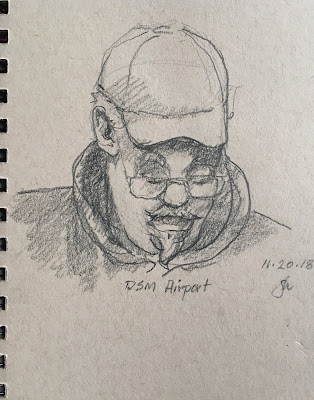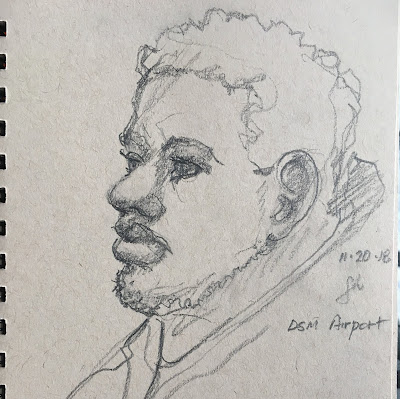One of my favorite artists is the well-known
Edward Hopper. His work is unmistakable in its spare and lonely beauty. Mr Hopper's work is quintessentially American and certain of his works are so familiar to us that they have become icons: "
Nighthawks," for example, and "
Automat" have appeared in print, online, as parodies and in all sorts of unusual places.
 |
| Edward Hopper boyhood home, Upper Nyack, NY |
Edward Hopper grew up in a small house in Upper Nyack, New York, a few blocks from the Hudson River. His family were prosperous merchants who provided him with encouragement and support as he studied to become an artist. According to biographers he was seen as talented by his parents while still in grade school. Eventually Mr. Hopper studied at the New York School of Art and Design, where he was influenced by
William Merritt Chase,
Robert Henri, and others. Although his ambitions were in the direction of fine art, he began his career as an illustrator. Again according to several biographies, he disliked working in illustration but needed the income. Several times in the very early 20th century he escaped the drudgery and went to Paris to study the masters. Oddly, although he was in the city during the early ferment of the Modernist movement, he later said he didn't recall hearing about any of that, and spent his time studying, painting, and visiting museums. Although the avant-garde was moving away from it, Mr. Hopper was more interested in realism.
 |
| Edward Hopper, "Smash the Hun," 1918 |
During the first two decades of the 20th century, Mr. Hopper continued to paint, even though economics forced him to work as an illustrator. His first oil painting sold at the 1913 Armory Show in New York, but seems to have aroused little interest. Mr. Hopper was actually quite good at the job of illustrating, despite his unhappiness. In 1919 one of his wartime poster illustrations (left) actually won a prize.
During those years of relative despondency he managed to continue advancing his art, simplifying and consolidating forms in etchings, assimilating and advancing his own vision. But it wasn't until the middle 1920s that he was able to abandon illustration, after he met and married Josephine Nivison, a fellow painter. For the rest of his life she managed his career and promoted his work. Although she subordinated her own career, Ms. Nivison continued to draw and paint alongside Mr. Hopper from that time on.
The two had met in 1923 in Gloucester Massachusetts while on separate painting sojourns, and it was through her urging and efforts
 |
| Edward Hopper, "The Mansard Roof," watercolor, 1923 |
that he entered a half dozen watercolors he did that summer in a show at the Brooklyn Museum. One of my favorites of Mr. Hopper's watercolors is that very one, "
Mansard Roof." To my eyes, the work retains its freshness even now, a century later. In my mind I see Mr. Hopper, a tall and rather dour fellow in a cap, sitting across the street to sketch what was then considered a rather ugly old house. But in the image we can see future works that have become iconic. For example, "
House by the Railroad," dating from only two years later and now in the Museum of Modern Art in Manhattan, is almost as well-known as Nighthawks.
The late 1920s and particularly the early 1930s were the years that cemented Mr. Hopper's success and ensured his place in the pantheon of world painters. During those years he sold several dozen paintings, a number of them to major museum collections. Another favorite of mine, "
Chop Suey," appeared in 1929 and remained in private hands until not very long ago when it sold for an unimaginable $92 million.
 |
| Edward Hopper, "Early Sunday Morning," oil, 1930 |
Perhaps my favorite painting by Edward Hopper is "Early Sunday Morning," dating from 1930, when he was beginning to have his greatest leap of success. The painting shows a strip of store fronts, deserted in the slanting light of a very early morning. The painting juxtaposes a series of rectangular and square shapes comprising straight lines with a single round shape that shines against a dark window. The raking light catches the ball atop the barber pole and gives an echo on the rounded top of a fireplug two doors down the street. The flattened space is confining, so that our eyes search back and forth along the businesses, all closed. No people intrude on the implied quiet of the deserted city.
Mr. Hopper disliked analyzing his work and insisted that everything was there, on the canvas, that he had to say. Perhaps so. Certainly for me and for many the lack of implied narrative allows the mind to wander from one scenario to another, from past experience to future possibilities, from the real to the imagined. And that is what attracts me to Edward Hopper: he allows the viewer to think and feel and draw his own conclusions.

One final favorite by Edward Hopper is "New York Movie," dates from 1939, the end of his most successful decade. In this one, he shows us a vanished world of movie theaters. The usherette, as they were known, stands in a head-down, forlorn posture along the right hand wall of the theater, lost in thought, her blond hair glowing. On the left side of the composition we can see deeply into the viewing auditorium where a couple have seats on the aisle near the front. The artist also shows us the stairway that may lead to balcony seating. The composition is brilliantly executed between the lighted part on the right and the darker to the left but also provokes an imaginative response--what is she thinking? where do the stairs lead? and so on. It is a scene of isolation in the midst of one of the most popular mass-communication venues of the 20th century, a metaphor perhaps of city life in those increasingly perilous times.
---
Previously
Selling Chop Suey
Favorite Artists
Favorite Artists 2
Favorite Artists 3--Grant Wood
Favorite Artists 4--Diego Velazquez
Favorite Artists 5--Andrew Wyeth
Favorite Artists 6--Wayne Thiebaud



























